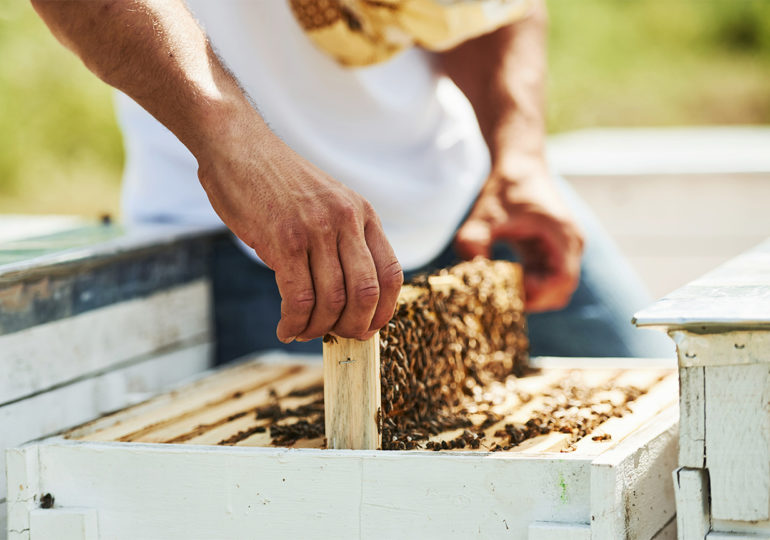 Véto-pharma
Véto-pharma As the days are getting longer, and we are all looking forward to those extra rays of sunshine, you are not alone in the desire to stretch your legs and get fit for the warm season. Your bees are “stretching their antennae” too – so to speak – to prepare for a new colony buildup. Eggs are already being laid, and as soon as the first flowering sets in and pollen and nectar become available, forager bees are beginning to fly out to collect much-needed nutrition for the colony.
Although varroa may not be your very first thought when you check upon your bees after the long winter months, this time of the year offers you an opportunity that will not return until the next winter treatment is due at the end of the year. Many of us begin the New Year with new resolutions, considering what we would like to implement change, clean-up, renew, or improve things in our lives, our homes, or about ourselves. As beekeepers, hive management, bee health and nutrition, and economic goals for the upcoming season are likely to represent some of the themes of our New Year resolutions.

One way to realize those well intended resolutions and improve honey bee health early in the season, is to start considering varroa treatments as soon as you plan the first visit to your hives. We know that the amount of bee brood in our colonies will increase in the upcoming weeks and months.1 We also know that the development of the varroa population is somewhat lagging behind bee brood development, which makes perfect sense, as varroa mites need the presence of bee brood to be able to reproduce at all.1 This sheer fact in addition to seasonally low monitoring numbers can lead beekeepers to think: Out of sight, out of mind. Meaning, as long as there is no significant varroa infestation present in the hives yet, why think of varroa treatments?
While it is certainly not time- or cost-effective to treat against varroa mites too often or with a mite load of (almost) zero (Psssst! It’s never really “zero”…), early spring treatment offers you the opportunity to reduce varroa mite and viral pressure in your colonies early on. Beekeepers often focus on the late summer or fall treatment, and for good reason. Varroa mite counts after the honey harvest are high1, treatment thresholds have constantly decreased over the last years, and treatment timing has become a matter of colony survival after the summer. However, it is precisely the lack of bee brood that provides opportunity for a quicker and more effective treatment in early spring, before the first honey flow.
Most miticides, including amitraz, the active ingredient of Apivar, target varroa mites when they are attached to their adult bee hosts and thus openly exposed to any potential treatment. Mites in the capped brood cannot be reached until they emerge from the brood cell. Thus, it will not come as a surprise to you that treatments are more effective, the less mites are “hiding out” in bee brood cells. The ideal example of this is the winter treatment with oxalic acid in completely brood-free colonies, a few weeks after the first frost.
Although the bee brood already begins to grow in spring, the total amount of brood present in the hives before the first honey flow is low enough to ensure ideal conditions for an efficient and thorough clean-up1, reducing the mite load before the honey season significantly. The six-weeks Apivar treatment, applied in time before setting up your honey supers for the first time in spring, provides a reliable long-term efficient treatment. As a contact miticide that is independent of ambient temperatures, there are no concerns about cool temperatures during the Apivar spring treatment either, since they do not affect efficacy.2
Trying it on your own colonies, you will notice that a prolonged treatment period of 56 days is not necessary for the spring treatment – 42 days are easily sufficient. Your colonies will thank you for reduced mite numbers throughout the season and some added benefits for colony health.
For more information, read our article “Treatment with Apivar lowers DWV titers and reduces honey bees’ susceptibility towards agricultural pesticides“
References :
1- Alexis L. Beaurepaire, Klemens J. Krieger and Robin F.A. Moritz – Seasonal cycle of inbreeding and recombination of the parasitic mite Varroa destructor in honeybee colonies and its implications for the selection of acaricide resistance – 2017
2- There is no temperature constraint to use Apivar, though Apivar should be stored below 30°C. Activity in the hive may be reduced with a lower temperature, resulting in less contact with the strips.
APV-116-US-N01-01/22
Join the Véto-pharma community and receive our quarterly newsletter as well as our occasional beekeeping news. You can unsubscribe at any time if our content does not suit you, and your data will never be transferred to a third party!
© 2019-2025, Véto-pharma. All rights reserved